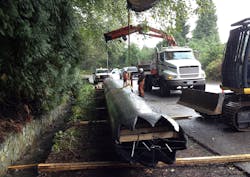New culverts help salmon, and roadways, in West Vancouver
Fighting upstream against turbulent currents is difficult enough. But spawning salmon in British Columbia and the Pacific Northwest also must swim through tens of thousands of failing man-made culverts that impede passage due to increased water velocity, washout and maintenance issues.
A variety of aquatic species—from Brook Trout in Virginia to Coho Salmon in Washington State—are unable to access habitat due to corroded and collapsing culverts. And failing culverts are affecting roadways and residents as well.
“A lot of the storm-water conveyances like culverts are failing,” said Cameron Magnus, a civil design technologist with ISL Engineering and Land Services Ltd. “So we need to replace them or address them.”
Magnus looked at a variety of solutions to address a failing culvert in a tributary of Brothers Creek in West Vancouver. The oval corrugated metal pipe (CMP) had significant damage due to corrosion and was at risk of collapse, which would negatively impact fish passage and block the sole access road to a residential neighborhood.
ISL needed a no-dig, environmentally sound solution. Snap-Tite HDPE pipe with retrofitted HDPE baffles offered the best way to rehab the culvert without adversely affecting a sensitive habitat or disrupting residents.
The primary environmental concern in this situation was maintaining substrate and fish passage in the culvert, said Marie Mattadu, an environmental scientist with ISL Engineering. “Those concerns are dealt with by introducing a simulated stream bed, tail water control, and baffles.”
The HDPE pipe is long-lasting and allows on-site installation of custom baffle design. The oval shape offered a distinct advantage as it allows for maximum flow during high-water storm events, while the baffles help control velocity. Custom-made baffles will aid fish passage because they create complex turbulent flow which assist fish in ascending the culvert, create deeper water areas within the culvert where fish can rest periodically as they ascend the culvert, and help maintain substrate which contributes to complex flow patterns mimicking natural conditions.
“The flow of the water will drag in silt and natural materials, and the baffles will help secure natural stream-bed material throughout the length of the culvert,” said Snap-Tite Regional Manager Steve Fischer.
HDPE pipe also is inert, which avoids the deterioration process that occurs with traditional culvert products. CMPs can change the chemistry of the water as they break down, and lead to the accumulation of heavy metals in the water.
